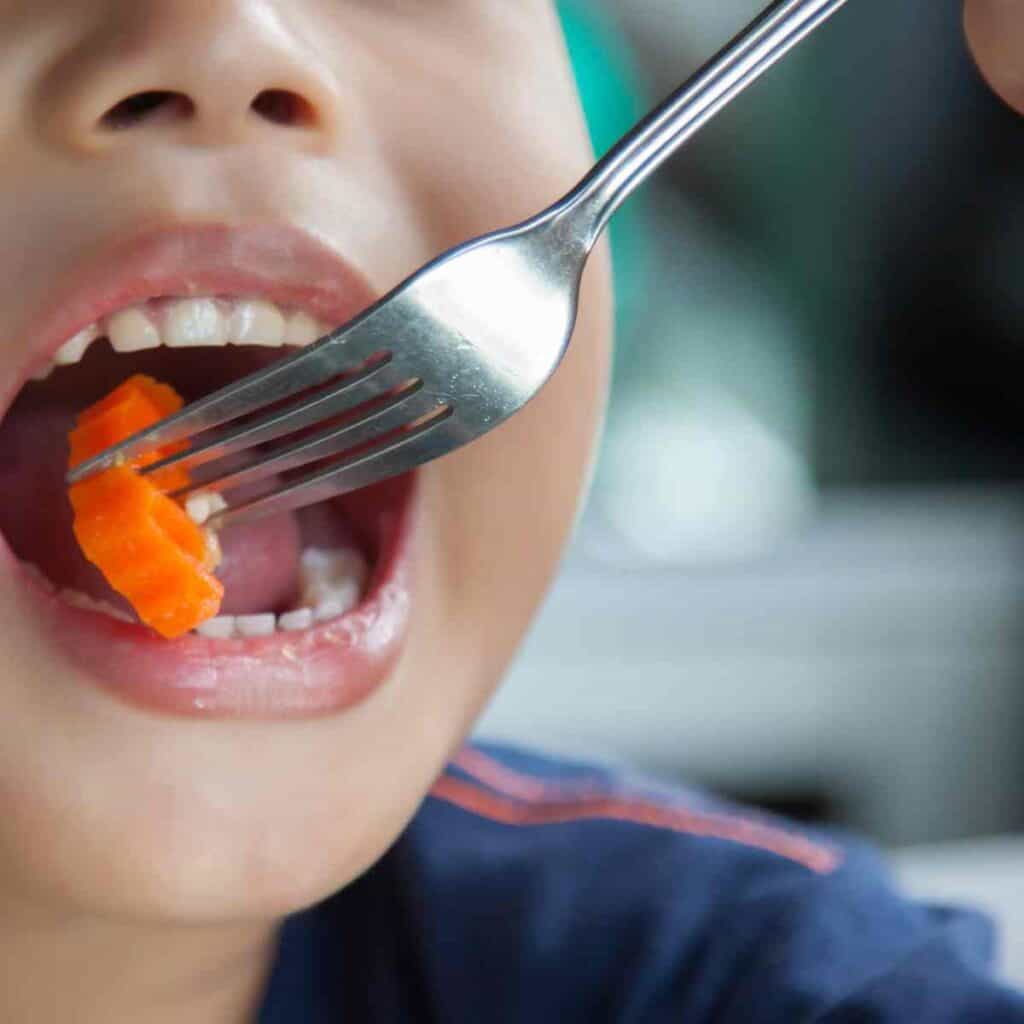Got a picky eater on your hands? How can you help them overcome these challenges? How can you get them to try new things and eat a variety of foods for healthy diet? Is this even a battle worth fighting?
I say it’s absolutely a battle worth fighting!! So many children aren’t getting the nutrients their bodies need to grow and repair themselves. With 4 kiddos, I’ve definitely faced phases of addressing a fussy eater, so I’ve picked up some tips along the way. So, today I’ll share my best 6 tips for helping your kids learn to eat healthy foods…without any arguing or power struggle!
In truth, so much of how children respond to new foods depends upon how the parent presents it and what the parent allows. That probably comes as good news to some of you, and bad news to others. But, simply consider how these tips might apply for your family, and I think you’ll be encouraged!
This post may contain affiliate links. Please see my full affiliate policy here.
Tip 1: Don’t buy anything you don’t want them to eat.
Okay, okay…hear me out! Picky eaters often have a handful of “approved” foods, or familiar foods, that they are happy eating. When you introduce something new that’s not on the child’s “approved” list, you’ll likely be met with lots of opposition. This is especially true for older children who have been picky eating for a while!
Your Chocolate Chip Energy Balls or Almond Flour Sausage Balls just can’t compete with their usual goldfish crackers (or whatever specific foods they prefer). But what if you simply don’t buy goldfish crackers this week? Instead, you let them know that you’ve made something yummy for them to try. When there are only healthy choices available in the pantry, it makes it much easier for a picky eater to make a good choice! And, bonus…if there REALLY are no goldfish crackers in the house, Mom can’t cave in!
Being intentional in what you allow into your grocery cart is the first step to holding everyone accountable for making changes. I’ll admit, the change is hard on everyone at first, but it gets easier very soon!
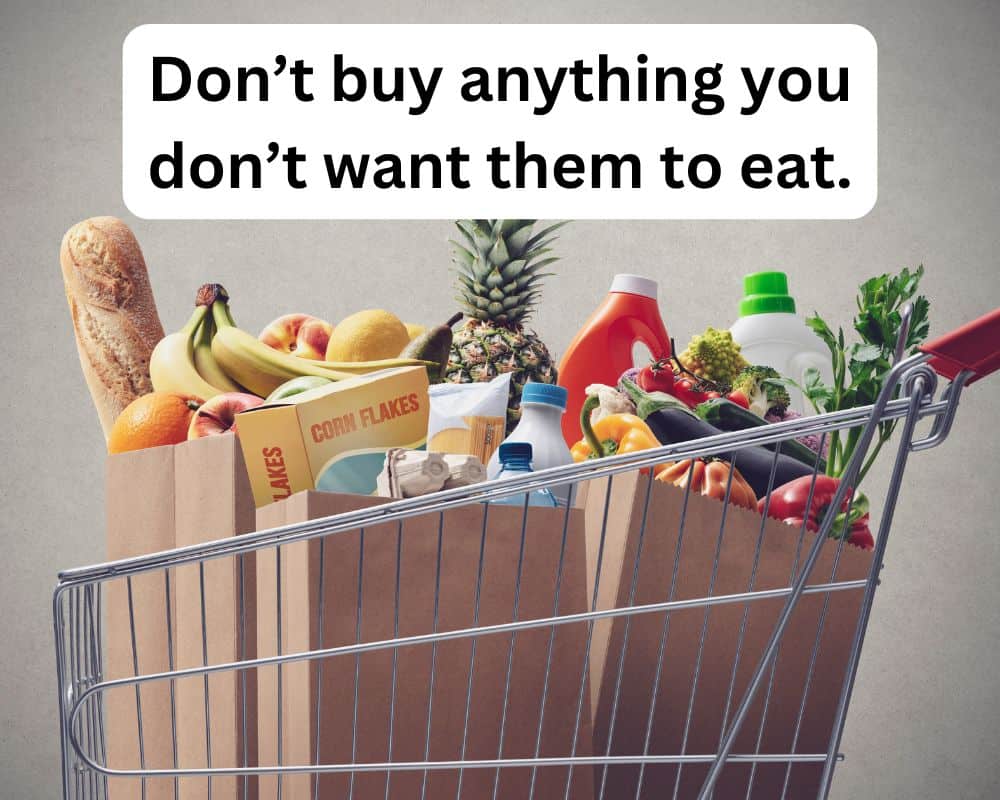
Tip 2: Encourage them to see if they are big enough to like it YET.
Picky eaters often label themselves. For example, they’ll decide that OTHERS may like a particular food such as green beans, but I am someone who does NOT like green beans. If we don’t work to prevent that self-labeling, they’ll wear that badge all the way into adulthood. And the last thing we want is adult picky eaters!
Instead, set an expectation that most older kids and adults like ____. So, let’s try it and see if you are big enough to like it YET. If you don’t like it today, then we will just try again later, when you’re a little older.
This approach works wonders! Reframing the idea of “I don’t like green beans,” to “I don’t like green beans YET, but I probably will when I’m older,” changes the game completely. Now it’s become a rite of passage, a goal, something to aspire to achieve. And we are working to get you there TOGETHER! So, trying unfamiliar foods becomes a positive experience because, if you like it, we can add it to your “grown up” list of foods!
In the meantime, let them see Mom, Dad, and other family members enjoying green beans at mealtime. Even picky eaters have the desire to grow up, mature, and do what others do. You can be sure they’ll take note, and you can be their biggest cheerleader as you are waiting for the big day to come!

Tip 3: Talk about how the food industry manipulates us.
This tip may not work well for young picky eaters, but if you still have a picky eater at age 5 or 6, it may be time to talk about the food industry’s manipulation. Actually, it’s a good conversation for the whole family!
In a nut shell, big-name companies hire food scientists to carefully manipulate ingredients like sugar, salt, and fat to make their products more addictive and stimulating to the brain. A useful resource on this topic comes from Pulitzer prize author Michael Moss. His book, Salt Sugar Fat: How the Food Giants Hooked Us, names specific companies and products. He even explains he term “bliss point”. Major food companies hire food technicians to determine the perfect amount of sugar and salt in everything from chips to soda to keep us coming back for more. There is absolutely no consideration for nutritional content, only future sales.
Katie Couric has also produced a documentary addressing the problems in our food industry called Fed Up, and it’s available for free on Amazon Prime. We watched it together as a family (we love a good documentary!). Among other notable tidbits, I was surprised to learn that school lunchrooms can now count pizza as a vegetable. Say what?!
Feeding You Lies by Vani Hari is another fascinating read on this topic. She explains why we can find “flavors” added to most any processed food’s ingredient label. Simply put, by the time the food is run through heavy manufacturing machinery, packed with preservatives, shipped around the world, and has waited patiently in the store’s stockroom or shelves for you to eat it, there’s no remaining flavor to enjoy. That means they need to chemically create flavors to make these processed products taste like real food again. These lab-made flavors are further formulated to trick your brain into craving more and more. So, by hijacking your taste buds, they can make you forget you aren’t eating real food, eat more than you should, and ultimately buy more of their product again next time. Big win for the food industry, but a big loss for your health!
Bottom line: Kids don’t like being tricked, so once you point out what these food companies are up to, they’ll pay attention to the junk food around them. And they’ll be better for it!

Tip 4: Talk about how nutritious foods help the body.
Picky eaters need to understand WHY we need healthy eating habits. I mean, if nutrition didn’t matter, I would eat more than my fair share of Reeses Cups, ya know?
In my house, I’ve used a silly analogy about good nutrition to help my kiddos understand this complex concept. My boys love to read about war, play war, watch war documentaries…anything war! So we’ve used the analogy of the nutritious foods being the “good soldiers.” Good soldiers can help your body fight “the enemy” (inflammation, disease, viruses, etc.). What if it’s time for a battle and your body doesn’t have any good soldiers around? Then it’s not ready to fight! You’re more likely to lose! And what if you give your body “bad soldiers” (junk foods) just before a battle? Then there is even more of the enemy for your body to fight, oh no!
Even picky eaters want to WIN the challenge, so setting it up in this framework is a great way to make mealtime about different ways to help the “good guys” win. And, again, Mom is on their team, trying to help them WIN the war! No power struggles here!
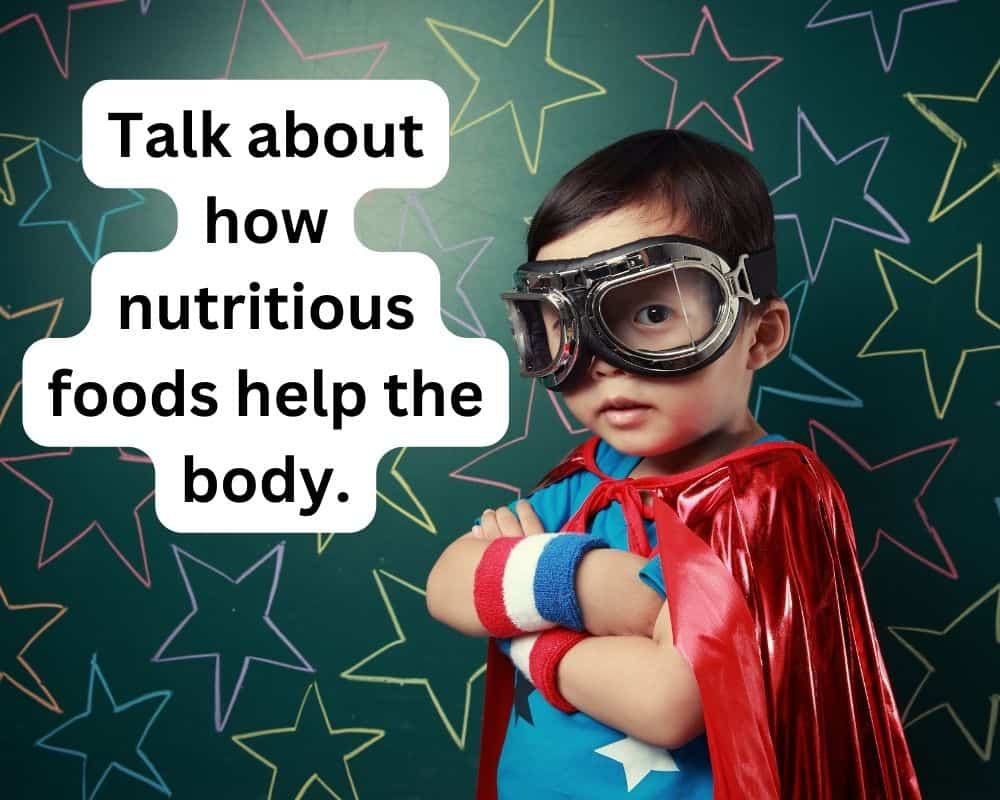
Tip 5: Teach them strategies for trying new foods.
Picky eaters, especially young children, need strategies to help them try different foods. One good strategy is incorporating sauces/dips that they like. Maybe you don’t love broccoli, but you do love ranch dressing. If broccoli is served, ask if you can try dipping it in ranch dressing. In the beginning, they may only eat it with ranch, but later, they may learn they don’t need the ranch after all!
Cheese and ketchup can also help make lots of foods more appealing. And don’t worry if the cheese to veggie ratio is a little overboard in the beginning. Cauliflower swimming in cheese is still a win if they eat it willingly! And down the road, they likely won’t need quite so much cheese.
This condiment strategy is also helpful because part of the meal is the child’s decision. Especially in larger families like ours, customizing family meals or making different meals for each child just isn’t practical. But allowing each child to choose his/her own condiments can help kids feel like they are getting to customize dinner to their preferences.
Another great strategy is alternating bites. Take a bite of something that’s not your favorite, immediately followed by something you enjoy. This strategy means you don’t get stuck eating one thing on your plate. Keep going, one bite at a time!
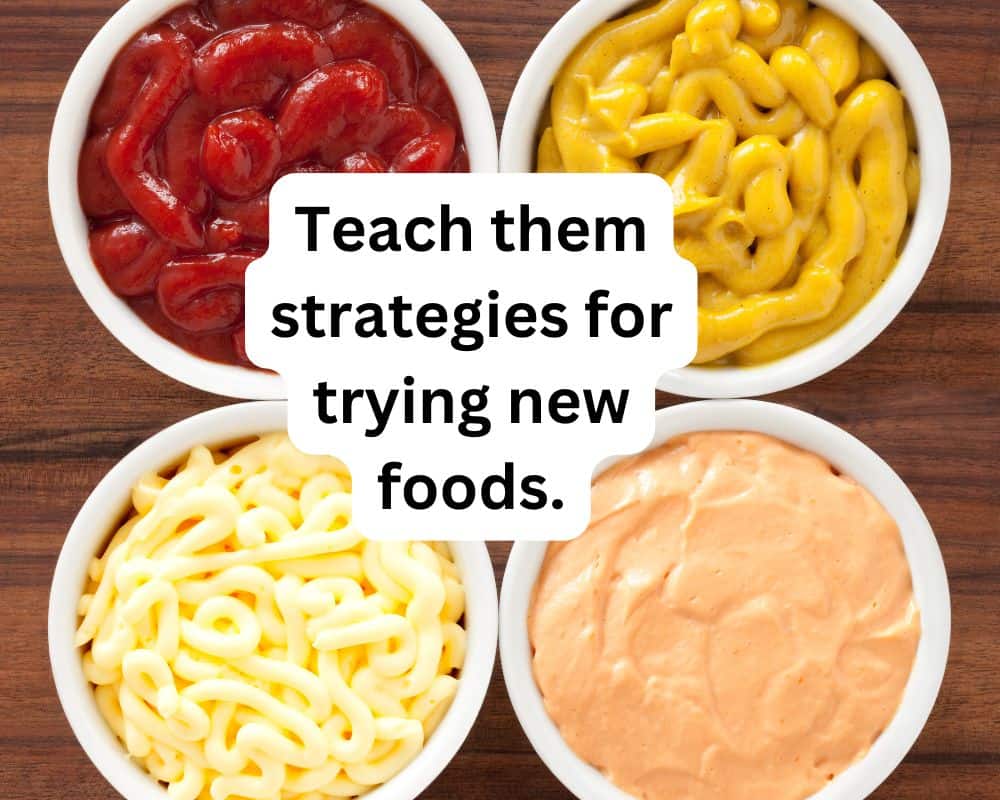
Tip 6: Make a no snacks rule.
At our house, you don’t have a “clean plate club”, but if you don’t eat what’s served, no snacks. You can’t have ANYTHING else to eat until our next meal. I’ll just stick the child’s unfinished plate in the fridge in case they are hungry before dinner is ready. And you know what? When a picky eater gets hungry, and there are no other options, that meal starts to look a lot more appealing! The same meal they didn’t want earlier, may just hit the spot a few hours later.
But, on the other hand, if they claim to be full after 2 bites of vegetable soup, then an hour later are allowed to snack on goldfish crackers, bad habits are being created. Picky eaters will learn that if they’ll just hold out a little bit, they can skip over the unappealing food and get what they really want instead. Teaching our kids to answer their bodies’ hunger cues by eating nutrient-dense, real food is actually a gift. Not to mention, we are teaching them to be good stewards of resources and not be wasteful.
Bonus Tip: Raw Milk for the Win!
One of my kiddos has been more of a challenge than the others. While we are slowly making progress and increasing her range of foods, I still want to make sure she’s getting the nutrition she needs to grow well. I was able to find a source for raw milk (Read all about raw milk benefits here), and I sweeten it with a little Homemade Hershey’s Syrup. I know this combo goes a long way in getting vitamins and minerals into her little body.
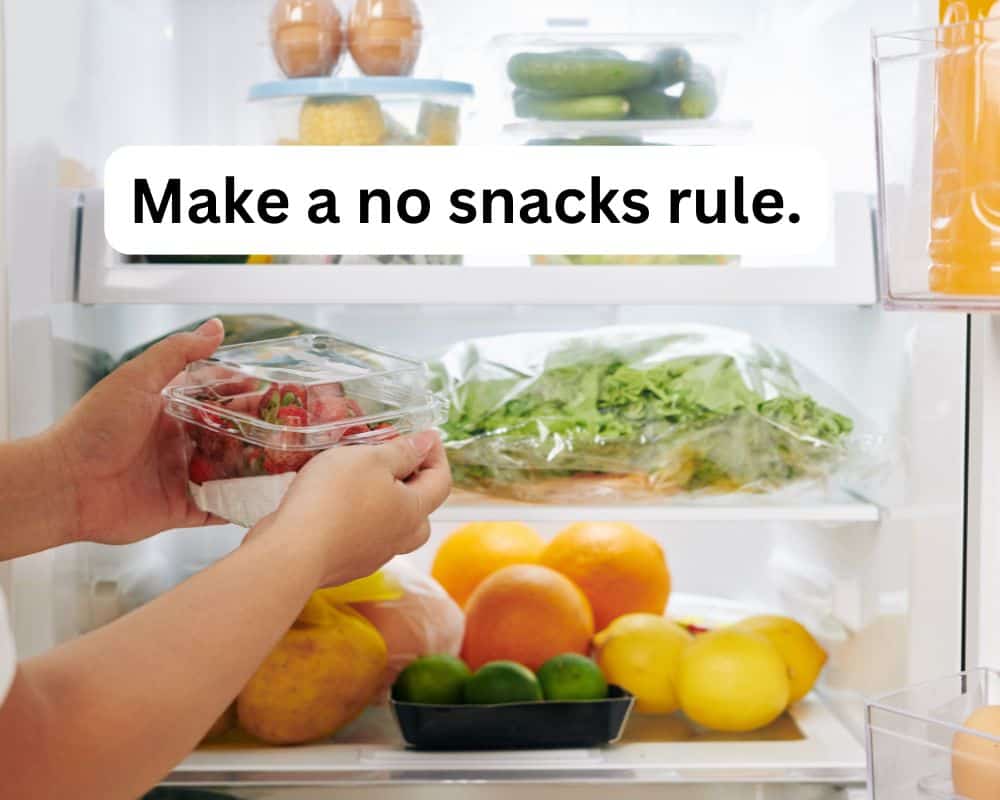
Picky Eaters Can Change!
Picky eaters definitely present some challenges. As a parent, we know that helping them overcome their pickiness will serve them well in the long run, but nobody is saying it will be easy to get there. It will take diligent work to help them make healthy food choices. So, don’t feel like you need to implement all 6 of these tips at once. Pick an easy one and start there. And maybe all 6 aren’t a good fit for your family and your goals. Take what works for you!
We all know the old saying, “If you keep doing what you’ve been doing, you’ll keep getting what you’ve been getting.” If you aren’t getting anywhere with your picky eater, the WORST thing you can do is to keep doing what you’ve been doing! So, start today. In no time, you’ll see little wins start happening. Even if it takes some time, creating a shift in your kids’ eating habits will be worth it! And they’ll be so much healthier and happier for it!
And one more tidbit…I always try to keep the bigger goal in mind. I don’t need my kid to be the most adventurous eater around. That’s cool, but not necessary. Instead, I just want to nourish them well so they can live healthy lives. And I also want them to be able to eat at friends’ & families’ homes without turning their noses up at the food that’s been prepared for them. When I keep the most important things in mind, it helps me not throw my hands up and reach for a frozen pizza. We join hands and keep working towards our goal…together!

Need Some Ideas for Healthy, Kid-Approved Recipes?
If you’re looking for some kid-approved recipes to try with your picky eater, be sure to hop over to my Nourish Them with Diligence page. You’ll find easy-to-follow recipes that have been tried and tested! And if you can’t decide on which one to try first, may I suggest my Anytime Cookies recipe? I haven’t met a kid who didn’t like them yet!

